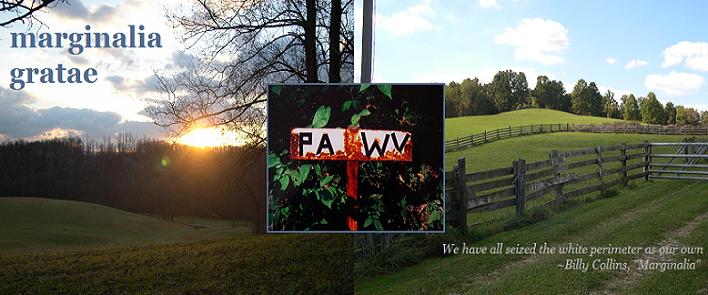I have been surprised, over the last several weeks, to realize just how difficult it is to address the question at hand: just what is the place of rhetoric in composition? Until I actually tried to articulate my position, in preparation for our program's first C&R colloquium of the season, I assumed, intuited perhaps, that my view of the field was clear and secure. Yet, any premise I draw becomes transient—-almost ephemeral–-the moment I try to build upon it. I’ve realized, then, that perhaps this is the nature of the field: it is adaptable, malleable. It is not a static body. It defies categorical conclusions. It is emergent. And it has been so for 2400 years.
Still, we have for the most part such anxiety about defining the discipline. Maybe this anxiety is in error: I am not convinced that ('big-D') Disciplinarity lends legitimacy or authority. With entities such as composition and rhetoric—-and despite my use of the conjunction I do believe they are discrete but similar systems-—we are dealing with complex forces, practices, objectives, histories, and pedagogies. With all the complexity, and all the possibilities for unique configurations, it seems to me impossible to view the field categorically or with the precision necessary for defining a discipline.
Having said that, I do think it is possible to offer a purview of the field. Describing what we do as a 'field' works for me because metaphorically it seems appropriate: a field, such as a hay field or corn field, offers an image of a vast space that can serve at different times many purposes; it changes according to multifarious and dynamic circumstances; to my mind (being a Pennsylvania gal) the landscape is rolling, creating a canvas of light and shadow at different times and in different seasons; it is both enduring and fragile; mostly, though, it is a location. In this way, the field of composition and rhetoric serves as a location for two components: composition and rhetoric. While different, they inform each other in significant ways.
I define rhetoric as the ways that symbols achieve efficacy. Here, I see 'efficacy' very much aligned with Aristotle’s notion of persuasion and 'ways' as "available means." I also recognize that the efficacy of symbols is not secure; it shifts with time, place, and purpose; it emerges in interaction. Defined such, rhetoric is inescapable—-but that doesn’t mean that it is limiting, because efficacy does not exist outside of kairos but rather emerges through it. I don’t believe this process is unlike poetry and poetic form: form must never be imposed on poetic expression. Rather, the expression must find the form that aids or enhances its expression; this is the only way to achieve poetic efficacy. I think this is the mistake that many current-traditional pedagogies make: in the name of efficiency, they compromise efficacy. I also think that it is the fear or resistance of imposition and efficiency that serves as the rationale that drives rhetoric out of composition.
The way I see it, though, composition is not only informed by rhetoric, it is itself rhetorical. Composition is both a creative and communicative act that adopts a mission that is closely tied to education and social justice. In fact, I don’t think it is possible to legitimately and responsibly discuss composition without addressing education and social justice. Rhetoric is implicated in all of these areas: the creative, the communicative, the educational, and the social. The creative act involves, among other things, invention, delivery, and cultural awareness. The communicative act involves utterance and audience, and here Furberg’s observation that “the phonetic act, the phatic act and the rhetic act are not subclasses, but parts of the locutionary act” is helpful in that it offers important insight into the dynamics of utterance: its power lies not in any one force but in the interrelatedness of several different forces: the epistemological (rhetic), the social (phatic), and the aural (phonetic). From a rhetorical perspective, Furberg’s synthesis of these three qualities associated with utterance may be understood in terms of the rhetorical triad, the interdependency of ethos, pathos, and logos in the Aristotelian paradigm, and the ways this relationship affords discursive efficacy. It offers a way of examining interaction through the dynamic alignment of rhetic/logos/text, phatic/ethos/author, phonetic/pathos/audience and the process of negotiation that occurs during interaction.
As for composition’s interests, the educational and the social, an important concern for education is “buy in” among different constituencies. At the institutional level, administrators and leaders must demonstrate and persuade state and federal supporters, as well as private investors, that their project, their institution, is worthy of continued or new funding. At the local, classroom level, instructors are hard-pressed to achieve their pedagogical objectives if students don't "buy in" to the course, if they don't--or can't--engage, take ownership, or otherwise invest themselves in the learning environment. At it's core, "buy in" is about persuasion and is, therefore, rhetorical. Further, because of its ties to and awareness of ethics, Rhetoric lends itself in theory and in practice to concerns of social justice. To my mind, and for all these reasons, rhetoric is solidly positioned in composition as much as it exists outside of it.
The question, then, is of relationship. Does rhetoric need composition? Probably. Mostly, though, our question, when it comes right down to it, is one of relationship, reciprocity, and symbiosis. I don’t think it is difficult to see evidence of these qualities “in each case.”
Saturday, September 29, 2007
Subscribe to:
Posts (Atom)

